

|
|
Select photographs of my many visits to The Missions of the United States South and Southwest built by Spain and Mexico between 1565 and 1823. All photographs taken by Kenneth A. Larson. All rights reserved. © 2008 - 2013. |
| Explanation. |
|
By Founding Date
| ||
|
South to North
| ||
Founded June 24, 1797 |
Personal ObservationsI visited again on a rainy Christmas Day while my wife waited in the car. I had only a few minutes to capture images of the mission in the rain. We have returned several times and attended Mass in July 2009. The church is about 100 feet from the famous San Andreas Fault with a steep bank leading to the fields below. |
Photo-Art Mission Art & Photo-Art |
|
Mission San Juan Bautista was founded on June 24, 1797 by Father Fermin Lasuen only 13 days after the founding of Mission San Jose and a month before founding Mission San Miguel. The San Juan Bautista Mission church is located about one hundred feet from the San Andreas Fault which tears through most of California and has played havoc on all of the missions during their over two hundred year history. There are many accounts of earthquakes at San Juan Bautista. The entire month of October 1798 was so turbulent that the staff slept outside as earthquakes struck as often as six times a day causing damage to the buildings. With the population increasing, plans were already progressing to build a larger church when an earthquake destroyed the church in 1803. Other earthquakes struck the mission including the famous San Francisco earthquake of 1906 and as recently as 2004. Following the 1803 earthquake, a new three aisle church was built. Because most churches were long and narrow and this church was wide, there was concern that the church could withstand an earthquake. To strengthen the building, all except the first pair of arches were closed. The interiors were painted by Thomas Doak, a Boston Sailor who jumped ship in Monterey and became the first Anglo-American resident in California. He was not the best artist, but he worked for room and board and his mixed paints still endure today. The mission was attended by many missionaries. Father Arroyo could preach in seven native dialects and wrote a dictionary of native languages. Father Tapis created a system of color coded music which was easier for the native people to follow. Following secularization in 1835, the church continued serving as a parish. The church suffered some damage from the 1906 earthquake but was repaired. A new bell tower was built, but not in the mission style. In 1949, the Hearst Foundation financed the restoration which returned the mission to it's original appearance. |
|
The San Juan Valley was inhabited by the Ohlone people (they called themselves Popelout or Popeloutchom). In 1790, the Spanish became interested in developing Missions to the east of El Camino Real. San Jose, San Juan Bautista, and Solidad were the result. Corporal Juan Ballesteros and five men came to the future site of Mission San Juan Bautista in the late spring of 1797. A month later, supervised by Fathers Jose Manuel de Martiarena and Pedro Martinez, they had erected a chapel, houses for themselves and the padres, and a granary. On Saturday, June 24, 1797, Father Fermin de Lasuen, Presidente of the California Missions, formally dedicated Mission San Juan Bautista (Saint John the Baptist in English). Father Lasuen established four Missions in the summer of 1797, San Jose just 13 days earlier. About two weeks after its founding, San Juan Bautista saw its first baptism, a ten year old native boy with the corporal as sponser. The corporal's son was the first non-native baptism, the first funeral was in September, for the infant son of the same corporal. Eventually, the Ohlone people were joined by Yokuts from the Central Valley. Six months after its founding, the Mission included of an adobe church, a monastery, granary, barracks, guardhouse, and houses for the neophytes. Over 500 neophytes lived at the Mission by 1800 when in October, an earthquake caused damage to the Mission. The rebuilding included an enlarged church and other new facilities. By 1803, there were 1,036 neophytes living at the mission. The new church, begun in June 1803, was built to accommodate the larger population but would take until 1812 to complete. About this time, the Mission recorded 1,036 cattle, 4,600 sheep, 22 swine, 540 horses, and 8 mules. Wheat, barley, and corn were produced. The neophites learned the skills of carpentry, tanning, weaving, and candlemaking. Father Arroyo de la Cuesta arrived in 1808 revitalizing the Mission. He is credited with the decision to build the new church with three naves. The church is unusual in having three aisles and is the largest of the California Mission churches and is the only structure of its kind built by the Franciscans in California. It was dedicated on June 23, 1812, the same year that Father Tapis arrived. The church was designed for 1000 people at a time when the Mission population was about 1,100. By the time the church was completed, the population had dropped to about half and the two side naves were walled off to separate rooms except near the altar. There is also the belief that the arches between the center and side naves were closed in to make the building more resistant to earthquakes. The church is 188 feet long, 72 feet wide, and 40 feet high with three foot thick adobe walls, and a red tile roof and floor. The cloister is 230 feet long. Another feature of the Guadalupe Chapel that some find amusing is the "cat door" to allow cats to enter the building in search of mice which could cause much damage. Interior work on the church continued beyond the dedication in 1812. Thomas Doak, an American carpenter who deserted his ship in Monterey to become the first American citizen to settle in California, came in 1820 and is credited with much of the interior painting. Doak settled in San Juan Bautista and married a daughter of José Castro. Some say Doak was not the best painter but his colors are still vibrant today. Doak also built and decorated the reredos (which hold the six statues) behind the altar. In 1817 the floor was tiled and the main altar and reredos were completed. Doak performed this work in exchange for room and board. When not working, the neophytes were locked into large dormitories to prevent mingling of the sexes. These confined spaces helped spread white man diseases which killed hundreds. Runaways were brought back and flogged. Father Felipe Arroyo de la Cuesta arived in California in 1807 and died in 1840. He was able to preach to the Native Americans in seven (and may have understood thirteen) of their dialects. In failing health, he compiled the first dictionary-like document of the native languages. He also wrote of an organ that has been written of often. In 1826 or 1829 Mission San Juan Bautista had received an English barrel organ that had been given to Padre Fermín de Lasuén by the British explorer Vancouver while in Monterey. Father de la Cuesta continued to administer the Mission until it passed into the hands of the Zacatecan Franciscans in 1833. Father Estévan Tápis joined Father Cuesta in 1815 after retiring as acting father presidente of the missions since the death of Fr. Lasuén in 1803. He is credited with developing choral singing among the neophytes and introducing color coded sheet music. He directed a choir of Native American boys and the Mission was known as "the Mission of Music." He died peacfully at San Jaun Bautista in 1825 at age 71. The Zacatecan took control of the Mission in 1833 but would only administer for two years. Secularization came to the Mission and it was stripped of its land and assets in 1835. Following Mexican independence, the new nation could no longer afford to run the Missions. The land was often offered to the neophytes who usually could not buy it or it was given or sold to soldiers instrumental in winning independence or sold to raise capital. The church was secularized in 1835 and continued as a parish church to the growing town beside it. The Mission has never been without a priest and is currently part of the Roman Catholic Diocese of Monterey. The new town of San Juan Bautista grew and several building remain today as part of a historic park. On November 19, 1859, President James Buchanan returned San Juan Bautista Mission to the Church. In 1863, President Abraham Lincoln signed an Act returning all of the California missions to the Catholic Church. A wooden tower was built in 1860 and later replaced with one of concrete, neither in harmony with the Mission style. It was this bell tower that had been by then removed that Alfred Hitchcock expected to see when filming Vertigo in 1958. The current bell wall was erected in 1976. An earthquake in 1906 damaged the church and other Mission buildings and church was rebuilt and strengthened. The "convento" is the only remaining remnant of the original quadrangle. Today, San Juan Bautista has the only remaining original Spanish Plaza in California. Around the plaza are a hotel, a stable and two adobe mansions, all as they would have looked 100 years ago. San Suan Bautista was bypassed by the railroad and failed to be come county seat and as a result, has remained little changed. Earthquake: The San Andreas Fault runs along the base of the hill below the cemetery. The structures suffered extensive damage in the earthquakes of 1800 and 1906. The El Camino Real connected the Missions from Baja California to Northern Alta California. Today it is hard to find any remnants of this important road, but a section runs adjacent to the church, just northeast of the cemetery. A note on Hitchcock and Vertigo: Many people have seen the Mission as a location in the 1958 Alfred Hitchcock film Vertigo. Hitch came to the Mission not realizing that the bell tower he needed had been removed. So he shot what he could and recreated the bell tower back at the studio. The bell tower that he expected was not the original or in the original style. Today a bell tower stands more in the style of the original. |
|
2nd & Mariposa Sts. San Juan Bautista, CA 95045-1164 Mailing Address: PO Box 1164 San Juan Bautista, CA 95045-1164 Exit US Highway 101 at California State Highway 156 (Hollister). After about two miles, left at the sign then make an immediate right onto Muchelemi Street. Follow into town. When the street ends, turn right on Second Street. The mission is on the left. San Juan Bautista is a few miles off Highway 101 about ten miles south of Gilroy. An El Camino Real Bell can be found at Monterey Street and Third Street where there is also a small museum. |
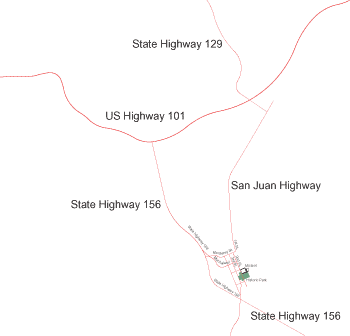
|
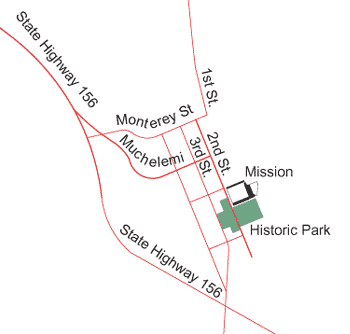
|
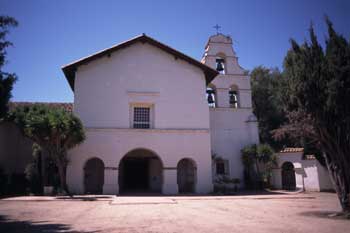 Chapel and bell tower. 7-26-03. |
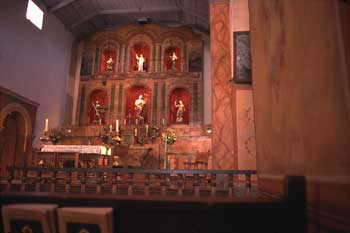 Main church. Only 3 aisle mission church. 7-26-03. |
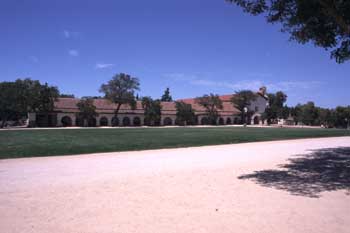 Mission San Juan Bautista. 7-26-03. |
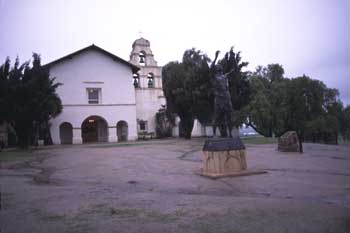 Mission Church and Statue. Photo date: 12-25-03. |
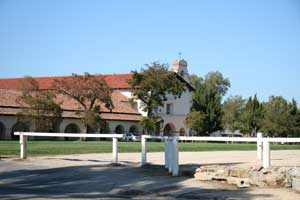
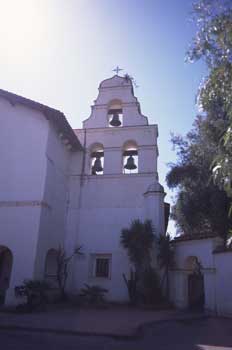 Bell Tower. Photo date: 5-29-04. |
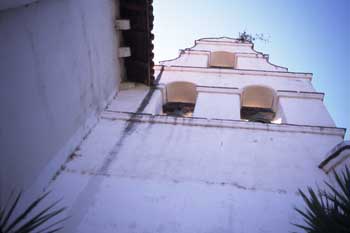 Bell Tower. Photo date: 5-29-04. |
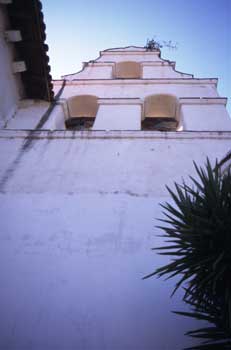 Bell Tower. Photo date: 5-29-04. |
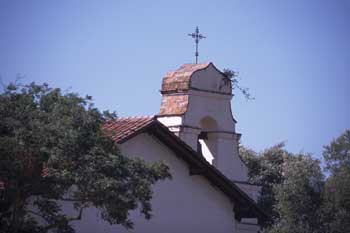 Bell Tower. Photo date: 5-29-04. |
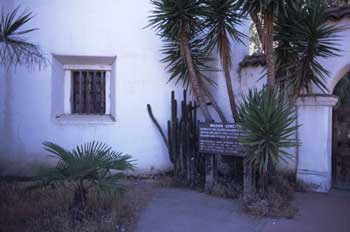
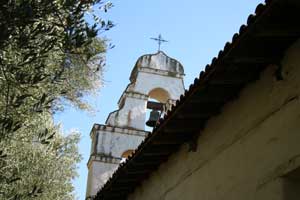 Bell tower from cemetery. |
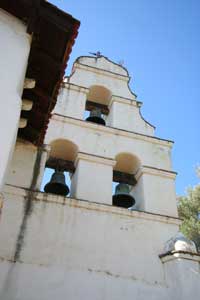 Bell tower from front. |
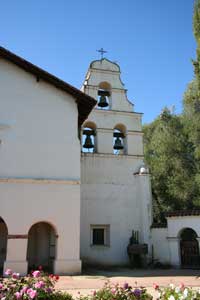 Bell tower from front. |
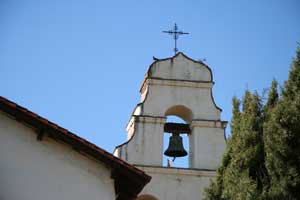 Bell tower from front. |
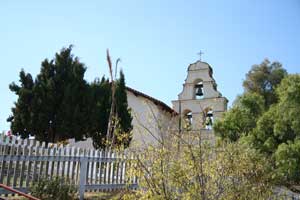 Bell Tower from below. |
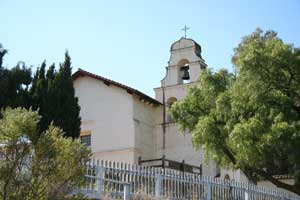 Bell Tower from below. |
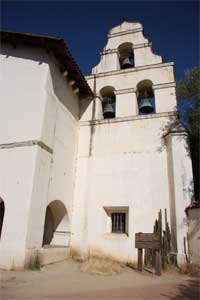 Bell tower from front. 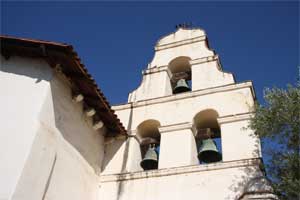 Bell tower from front. |
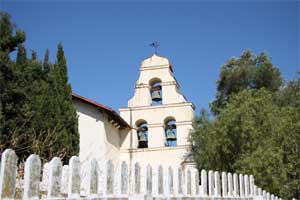 Bell Tower from below. 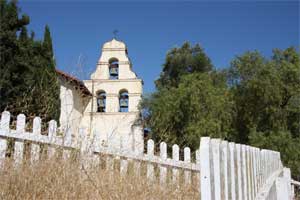 Bell Tower from below. |
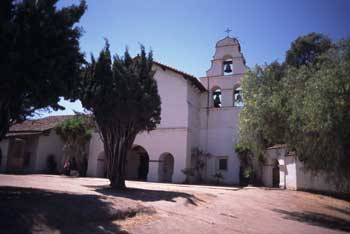 Chapel and bell tower. There is a story that Alfred Hitchcock came to this mission to use the bell tower for his Motion Picture Vertigo. When he arrived, he discovered that the second bell tower of which he had seen photos, had been replaced by a restoration of the original bell tower. He then had a bell tower constructed back in Hollywood. 7-26-03. |
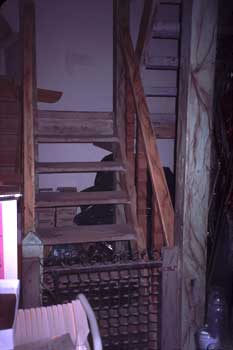 Stairway to bell tower. 7-26-03. |
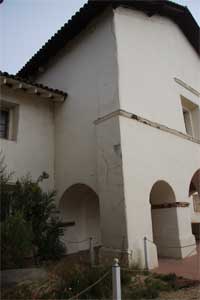
|
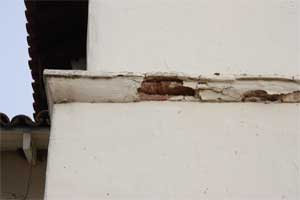
|
| Church. | |
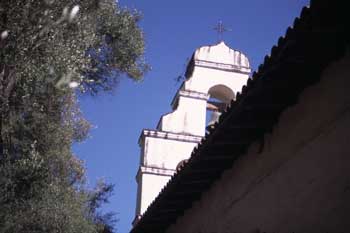 Back side of bell tower. Photo date: 5-29-04. |
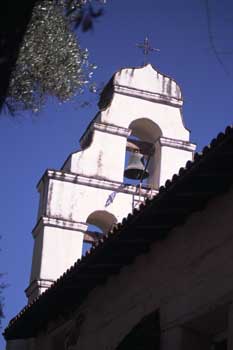 Back side of bell tower. Photo date: 5-29-04. |
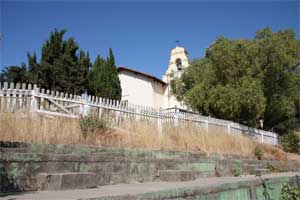
|
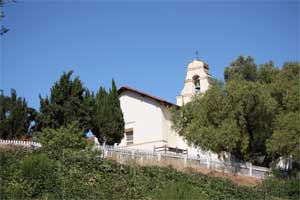
|
| Church from below, near the San Andreas Fault. | |
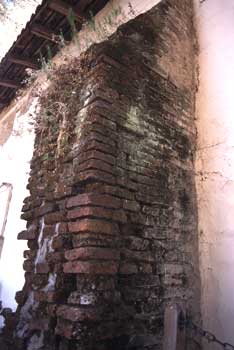 Buttress. 7-26-03. |
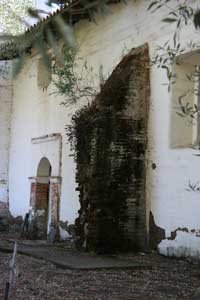 Buttress. 10-14-07. |
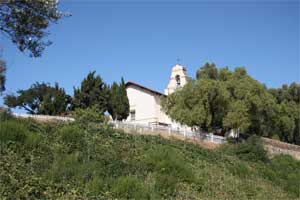 Church from below. |
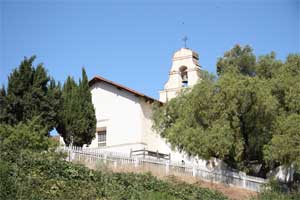 Church from below. |
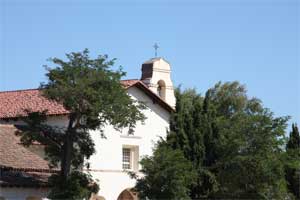 Church. |
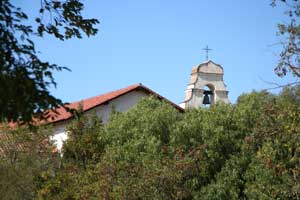 Church. |
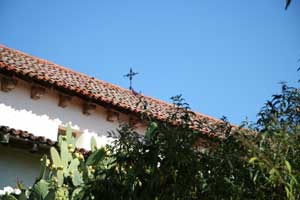
|
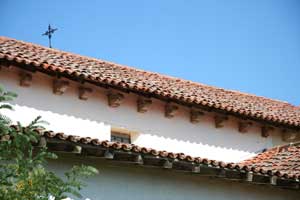
|
| Side of church. | |
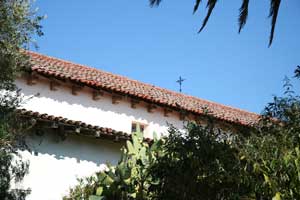 Side of church. |
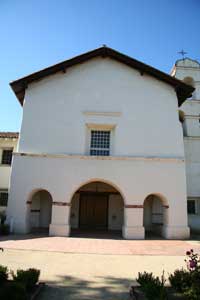
|
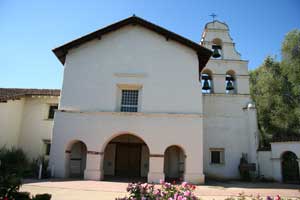
|
| Front of church. | |
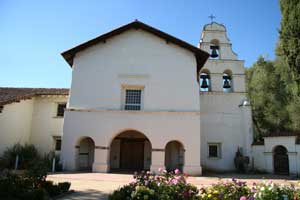
|
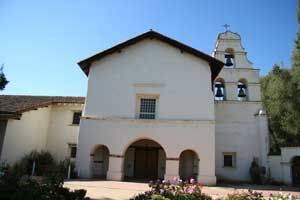
|
| Front of church. | |
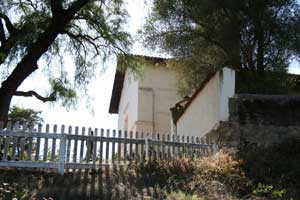 Chcurch from below. |
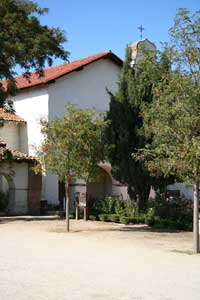 Front of church. |
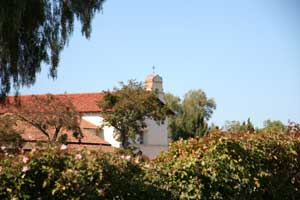 Church. |
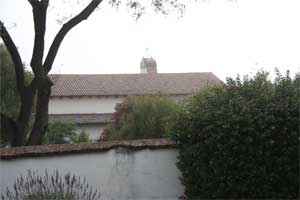 Church. |
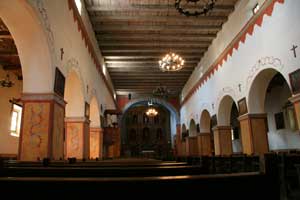 Looking back. |
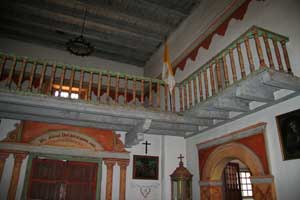 Loft. |
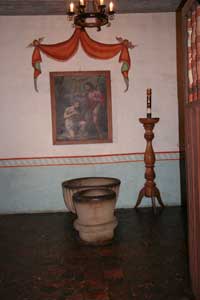 Baptismal. |
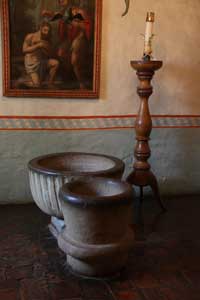 Baptismal. |
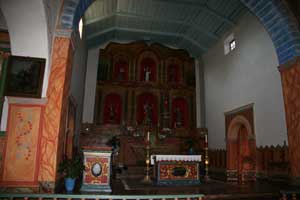 |
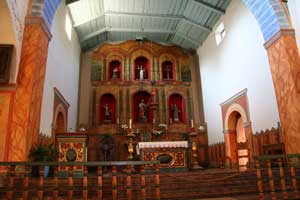 |
| Altar. | |
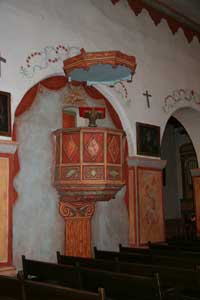 Pulpit. |
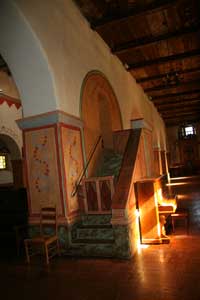 Stair to pulpit in side aisle. |
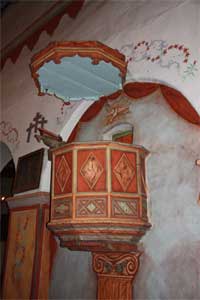
|
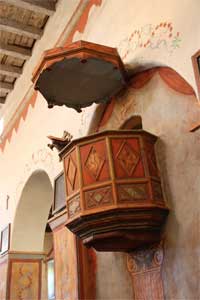
|
| Pulpit. | |
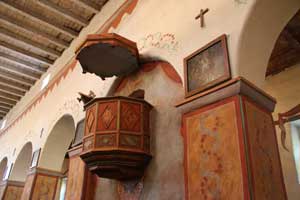
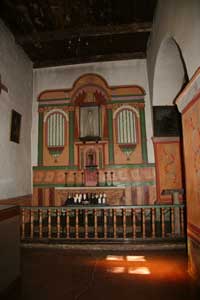
|
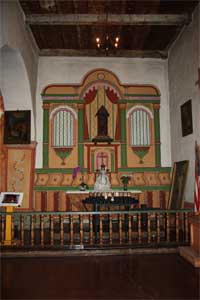
|
| Side altar. | |
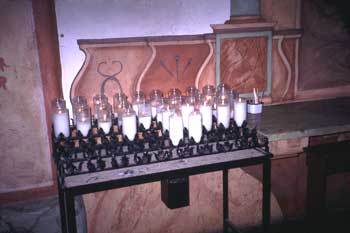 Prayer candles in Main Chapel. 7-26-03. |
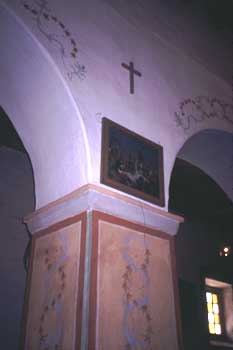 Stations of the cross in Main Chapel. 7-26-03. |
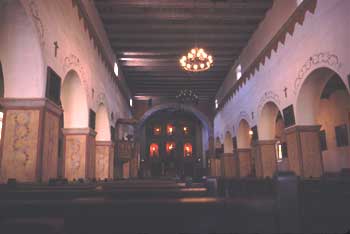 Church interior. Photo date: 5-29-04. |
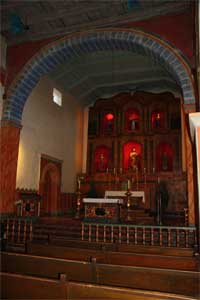
|
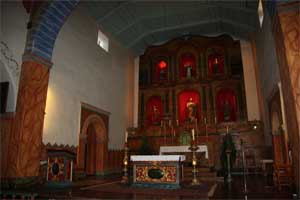
|
| Church interior. | |
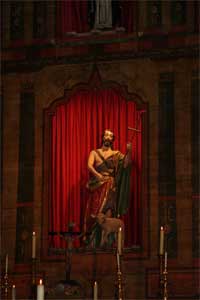
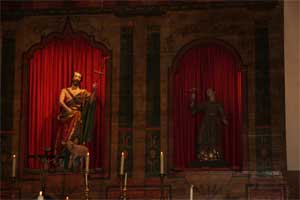
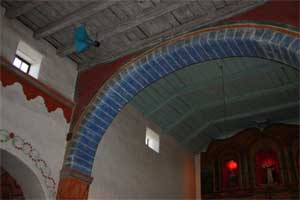
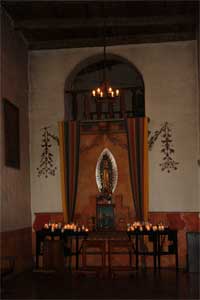
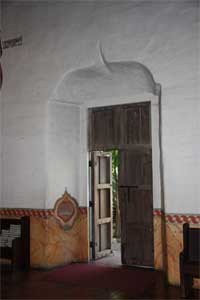
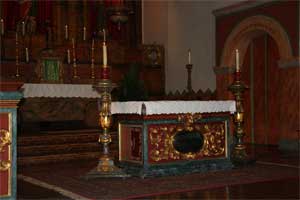
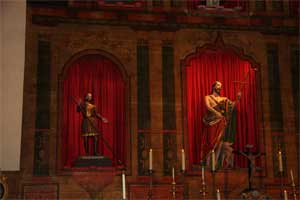
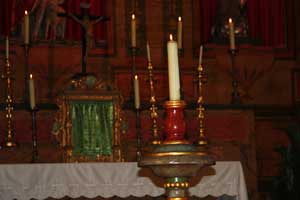
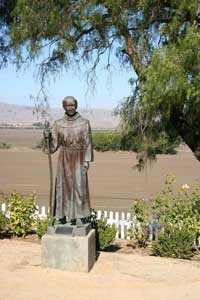 |
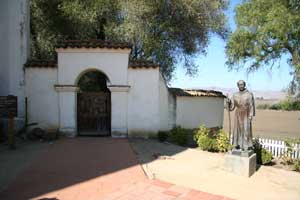 |
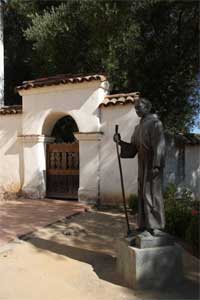 |
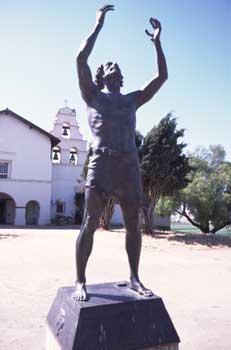 Luke, Statue. Photo date: 5-29-04. |
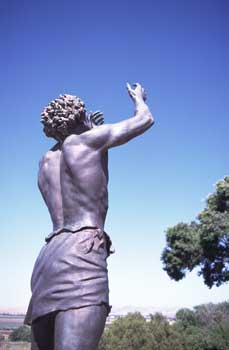 Luke, Statue. Photo date: 5-29-04. |
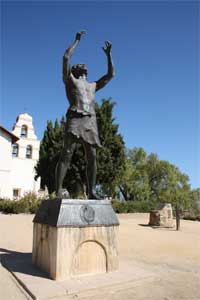 Luke, Statue. |
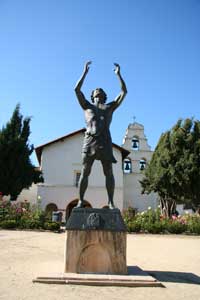 |
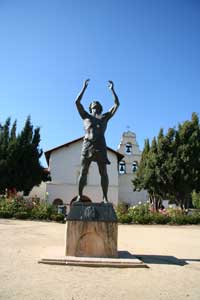 |
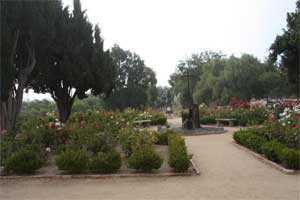
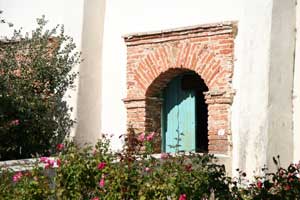 |
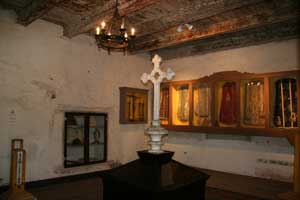 |
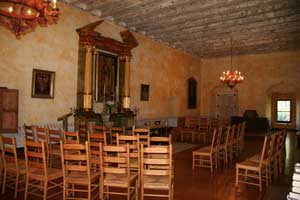 |
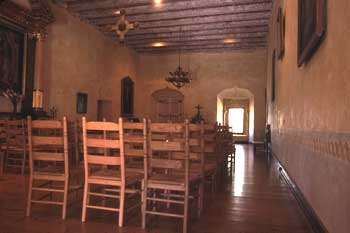 Smaller chapel. 7-26-03. |
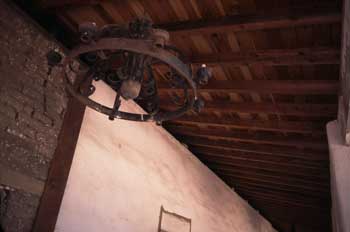 Light fixture. 7-26-03. |
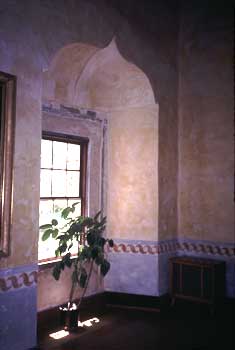 This window design in common to several missions. See a similar door at San Fernando Rey de España Mission. This is in the smaller chapel. 7-26-03. |
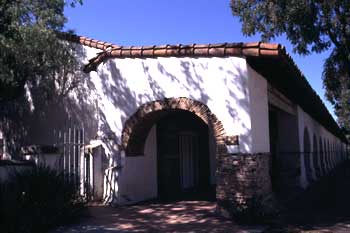 Entrance to Mission San Juan Bautista and Colonnade. 7-26-03. |
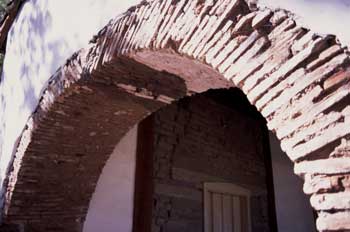 Colonnade. Photo date: 5-29-04. |
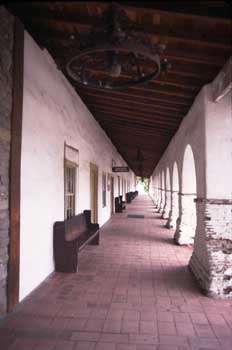
|
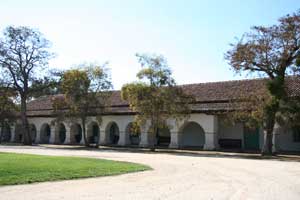
|
| Colonnade, one side of the Quadrangle. Photo date: 12-25-03. | |
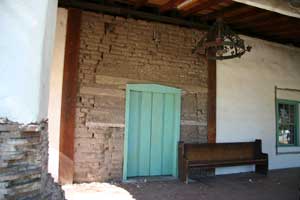 Colonnade |
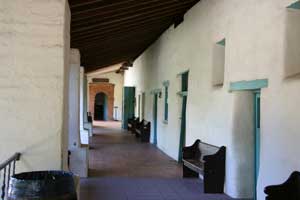 Colonnade |
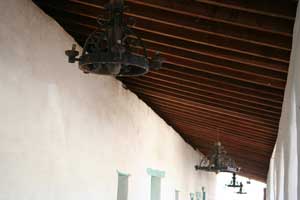
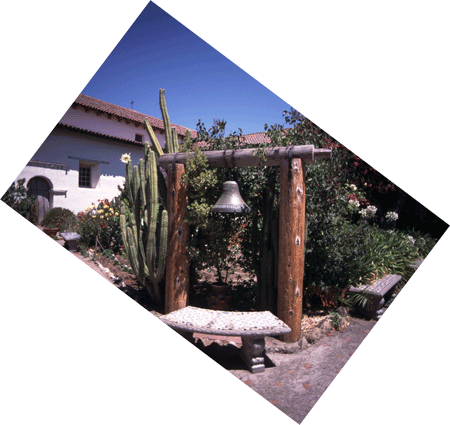
 Garden. 7-26-03. |
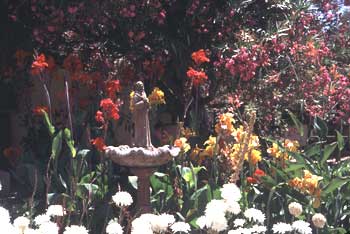 Garden. 7-26-03. |
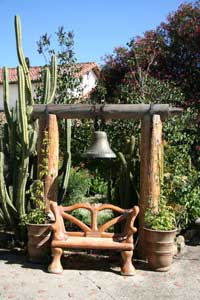
|
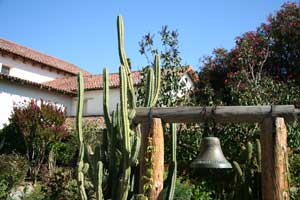
|
| Small bell on a frame in the garden in the Quadrangle. | |
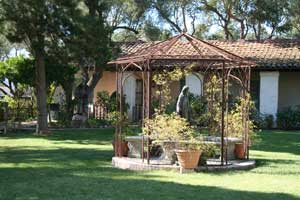
|
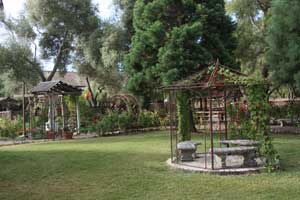
|
| A small metal framed gazebo in the garden in the Quadrangle. | |
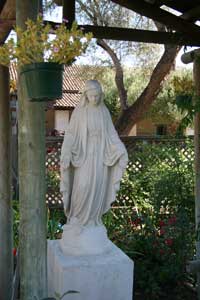
|
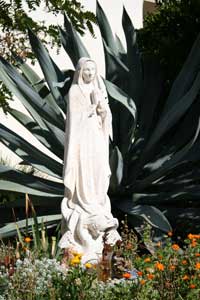
|
| Statues in the garden in the Quadrangle. | |
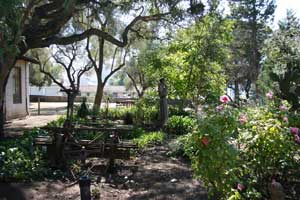 Garden. |
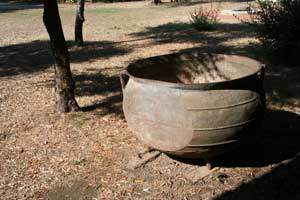 Kettle in the garden. |
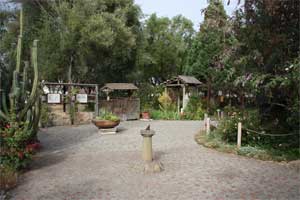 Garden. |
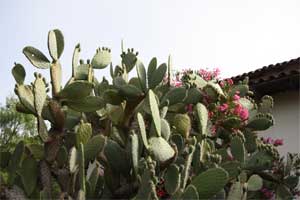 Cactus. |
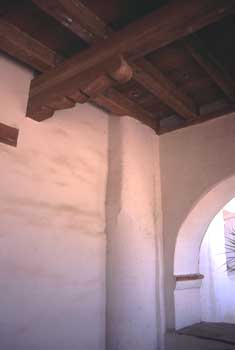 Corbel. 7-26-03. |
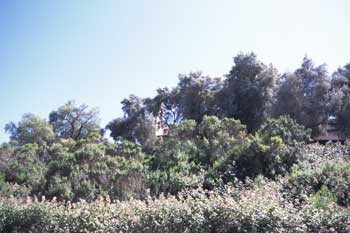 Mission from a distance from northeast. Photo date: 5-29-04. |
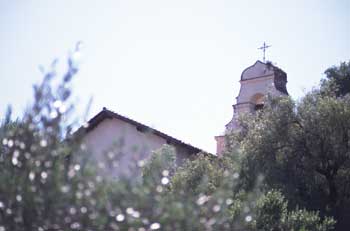 Mission through trees from east. Photo date: 5-29-04. |
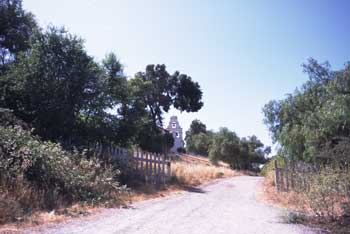 Mission from a distance from east. Photo date: 5-29-04. |
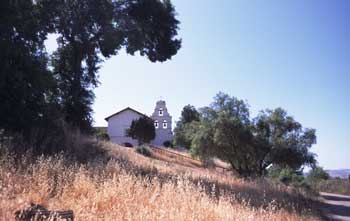 Mission from a distance from east. Photo date: 5-29-04. |
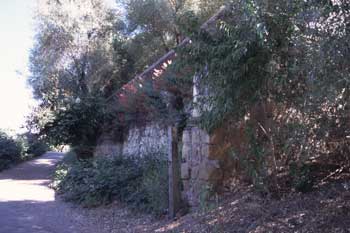 Retaining wall northeast of Mission Church. Photo date: 5-29-04. |
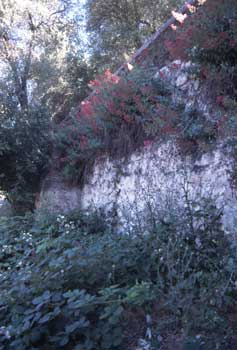 Retaining wall northeast of Mission Church. Photo date: 5-29-04. |
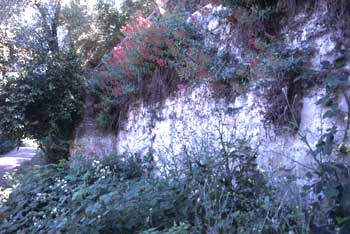
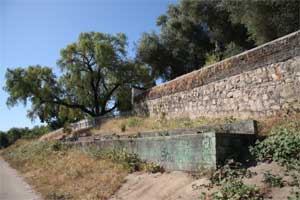
|
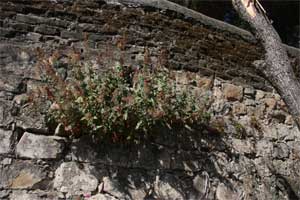
|
| Retaining wall northeast of Mission Church. Photo date: 7-26-09. | |
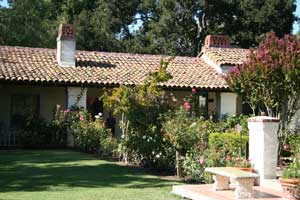
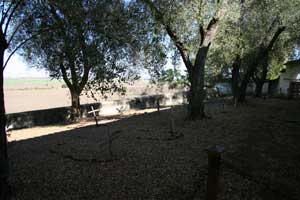 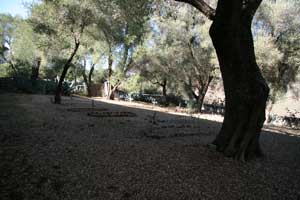 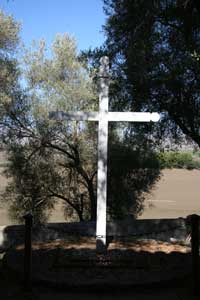 |
|
By Founding Date
| ||
|
South to North
| ||

|

|

|
| Note:This is not the official site for any of the places shown in US Mission Trail. US Mission Trail is not responsible for accuracy of the information. Hours of operations, prices, and exhibits are subject to change without notice. |
|
Support this Web Site I hope that you find this web site helpful. It started because of my love for the California Missions and interest in History and a desire to share my photographs and tales of my adventures. I don't allow paid advertising. This web site is for your benefit and enjoyment and I make no profit on it. For twenty years it has been supported primarily from my regular paycheck as a Set Designer. A non-tax deductable donation helps cover the cost of operating this web site and may be made to Kesign Design Consulting through PayPal. | ||
|
If you are in the need of a designer, please see my Set Designer portfolio site Set Design Portfolio. |
| Or donations can be mailed to the address on the contact page. |
|
Links
Home |
Contact |
Sales |
Ken Larson |
K L Images |
Places Earth
|

|
This site maintained by Kenneth A. Larson. Copyright © 2004 - 2023, Kenneth A. Larson. All Rights Reserved. Website content including photographic and graphic images may not be redistributed for use on another website. |

|

|

|